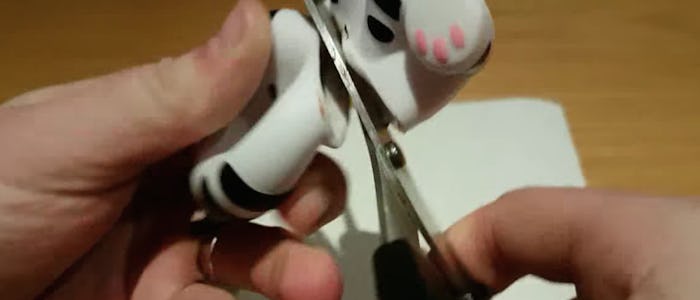Life
The Thing Lurking Inside These Bath Toys Will Make You Want To Burn Your House Down
The whole point of bathing our kids is to make them less dirty than they were before, so it seems cosmically unfair that bath toys are often guilty of harboring some pretty nasty stuff (and by "pretty nasty stuff," we mean mold, naturally). Of course it makes perfect sense that bath toys — with their tiny water-squirting holes — would make ideal breeding grounds for mold, but until videos of parents slicing up their contaminated Sophie the Giraffe toys started going viral, this wasn't quite the hot button issue it is today. Now, videos of moldy bath toys being cut open are all over YouTube — and we found one that's sure to make you go running for the bleach.
What's particularly interesting about this video from user Maphia Toyz Tv is that, as the captions explain, the harmless-looking little playthings are only about a month old, and were regularly squeezed out after every bath time. Still, as new and well-cared for as these toys apparently were, they were hiding some seriously horrifying stuff on the inside. The parent wielding the scissors decided to dissect the zebra and ducky after seeing dirt come out of them (which had to have been something of a surprise, because honestly they look totally fine on the outside). And uh, gross:
Ugh, why? And how? How does a bath toy that's been getting squeezed out get that moldy in just a month? It's enough to make you want to ban bath toys from your house altogether, even if that would make getting your kids into the tub about a million times harder. At the very least, you might want to avoid bath toys that have any kind of opening at all so water doesn't have the opportunity to stagnate and breed all manner of cooties in there.
But let's say you find some little squeezable bath time friends you just can't resist. There is a way you can prevent them from getting funky, if you're up for an odd sort of crafting project: As cleaning expert Jolie Kerr told Lifehacker, plugging up those "fun" squirty holes with a hot glue gun is a pretty reliable way to keep moisture out. (Is there anything a hot glue gun can't do?) That said, she warned, you'll want to check the glue frequently to make sure it doesn't become dislodged. Also, consider your child's age and the likelihood that she will or won't go ahead and chew that hardened glue glob right off.
Another option, Kerr suggested, is to go the opposite route and make the holes in your kid's bath toys even bigger.
"That will allow the water to drain out, and air to circulate, reducing the presence of the moisture that mold loves so much," Kerr said.
"It also allows you to get in there and clean the toys out using a cotton swab or rolled up paper towel."
If, however, you're interested in continuing to use your kid's favorite bath toys without mutilating them in some way, there are methods of sanitizing them that really work. According to Kerr, soaking them in a solution of either white vinegar or chlorine bleach (not both) and water should do the trick (soak from an hour to overnight), as will boiling them in either plain water or a water/vinegar solution. As for getting the bleach residue off post-sanitization, a run through the dishwasher will take care of that (in fact, you can put bath toys in the dishwasher on a regular basis for upkeep).
Not into chemicals? Check out this video from user Mumble for a bleach-free bath toy tutorial:
I know, I know — it all seems like an awful lot of effort, and a cruel joke the universe is playing on parents, considering it feels like more work to keep our kids' bath toys clean than it is to give them baths in the first place. But before you know it, they'll be taking showers and your bath will be blessedly rubber ducky free!
Check out Romper's new video series, Bearing The Motherload, where disagreeing parents from different sides of an issue sit down with a mediator and talk about how to support (and not judge) each other’s parenting perspectives. New episodes air Mondays on Facebook.
